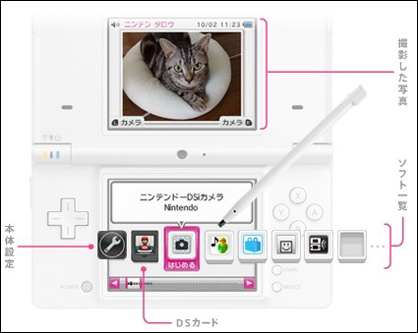DSi’s Rumored Virtual Console Paving Way for Multiplayer Zelda?
Posted on October 28 2008 by Nathanial Rumphol-Janc
Nintendo recently released another firmware update to the Wii software
that all Wii owners are forced to download if they wish to keep
shopping in the Virtual Console, the retro heaven for Nintendo gamers.
Lately the internet has been buzzing with excitement revolving around
the new DSi and its capabilities. While official confirmation of the
DSi’s Virtual Console remains behind sealed lips, the Wii software
update along with a Japan-only announcement bring about a curious
detail that suggests the VC is no longer strictly a Wii-thing.
 According to GoNintendo,
According to GoNintendo,
the Japanese Wii owners have received a message apologizing for the
recent downtime of their VC service caused by maintenance. During this
break, all mentions of Wii points will be changed to Nintendo points.
Some improvements to the purchasing form will also be made by further
clarifying which controllers are suitable for which games as well as
some cosmetic changes. My European Wii received the controller updates,
but Wii points remain Wii points.
As all gamers know, Japan is
always first in line for everything Nintendo, which is why so many
gamers look to the land of the rising sun to get a glimpse of the
future of gaming before it hits our shores. But calling Wii points
Nintendo points, doesn’t necessarily mean that the points system is
becoming a universal Nintendo credit. Even if it did, why would I be
raving about the possibility of a portable Virtual Console at this
point?
Details about the yet unreleased DSi reveal the
surprising absence of a GBA slot. The new handheld is also said to
feature much more and far more sophisticated downloadable content than
its predecessors. Earlier, VC Reviews
speculated that GBA games along with older Gameboy titles may be the
first content available for download. We already know there’s going to
be DSiWare available for purchase, though the details at this time are
still vague. As usual, Nintendo is silently savoring the moment as they
sit back and watch us squirm in excitement. What ever the case may be,
so far signs point to a DS Virtual Console being around the corner.
the VC to the handheld market naturally allows for any type of handheld
games to be ported over. What I’m personally especially looking forward
to is seeing the handheld Zelda classics to stop collecting dust and
get introduced to new generations. But what’s even more interesting, is
the possibility of seeing the first ever handheld Zelda re-released in
its two-screened glory.
In 1989 Nintendo released Zelda Game
& Watch as the final part of their first venture to the handheld
world of gaming. The earliest Game & Watch games were released as
early as 1980, nine years before the Gameboy, making them the first
ever portable video games. Each unit had only one game, which used one
or two LCD screens, similarly to the Nintendo DS. The Zelda game was
later featured as a hidden bonus game in Game & Watch Gallery 4 for
the GBA. The port however suffered from the limitations of the GBA as
everything had to be crammed on one screen.
aside, the new features are also paving way for much more than just
re-released classics. The as the DS and DS Lite have already shown,
handhelds today are about more than just playing Tetris on the way to
school. Wireless multiplayer is no longer science fiction, but instead
part of everyday gaming. Even Zelda jumped in with the release of
Phantom Hourglass. While the game made a brave attempt to make the most
out of the DS’s capabilities, in the end the multiplayer turned out to
be nothing but a minigame, that was merely a byproduct of the actual
game everyone wanted to buy in the first place.
Phantom
Hourglass wasn’t the first Zelda to try its luck with the portable
multiplayer concept. The first ever multiplayer Zelda, The Four Swords,
suffered from insane hardware requirements. To play the game, each
player needed their own copy of the game, a GBA unit, and a hoard of
cables to connect them to one another. While the game received praise
for being a fresh experience and bringing the multiplayer aspect to the
franchise, it quickly slipped under the radar and was completely
ignored by a majority of Zelda fans. Many don’t even count it as a
legitimate Zelda game. One can only hope that Nintendo sees the
potential this game could have as a downloadble game in the DSi’s
Virtual Console, with the multiplayer turned completely wireless.
The
second game, Four Swords Adventures, was a far more approachable
concept as you no longer needed four copies of the game. The fallback
this time was that the cables you used to connect the GBA’s together
were useless with FSA. You needed new cables that connect to the
GameCube. The few people who actually managed to rake together enough
cash and have a couple of friends ready to do the same in order to play
Four Swords were forced to buy another set of cables, which just like
the other ones, weren’t really useful for anything else. One has to
wonder just what was Nintendo thinking.

Phantom Hourglass
thankfully only required one game cartridge to give people a chance to
try out the multiplayer. Though, not all content was available without
two cartridges. While the PH multiplayer pales in comparison to the
greatness of the Four Swords games, it was clearly a step to the right
direction, making the games affordable and accessible. Now that
Nintendo has gotten their feet wet with the whole concept, it’s time
they finally deliver what everyone seems to be waiting for. Sure,
nobody minds seeing classics like Link’s Awakening re-released, but
what I really want to see is what Nintendo can do with the concepts
they’ve been toying with for years now. I want innovation, dammit!





